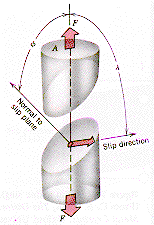|
||||||||||
|
||||||||||
| In
a crystal, initial slip takes place on a particular slip plane in a particular
slip direction. The diagram shows the situation for a sample in uniaxial
tension for which the resolved shear stress in the slip direction is given
by tres
= s
cosf
cos l.
Slip will occur when the resolved shear stress becomes equal to the critical
shear stress, tcr,
a parameter that depends upon the microstructure of the sample.
Dislocations are responsible for slip in crystalline solids and these active dislocations are provided by the action of Frank-Reed sources on the slip plane. The critical resolved shear stress depends upon the spacing, L, of the pinning points associated with the Frank-Reed source; the closer the pinning points the higher the critical shear stress. The Frank-Reed source will cause dislocation multiplication and slip when the applied stress is greater than tcr = 2Gb/L, where L is the distance between the pinning points of the source, G is the shear modulus of the sample, and b is the Burgers vector of the dislocation. Typically, L = 104b, so that tcr = 2 x 10-4G. |
||||||||||
 |
||||||||||
| From:
Callister,
"Materials Science and Engineering," Wiley (1994) |
||||||||||